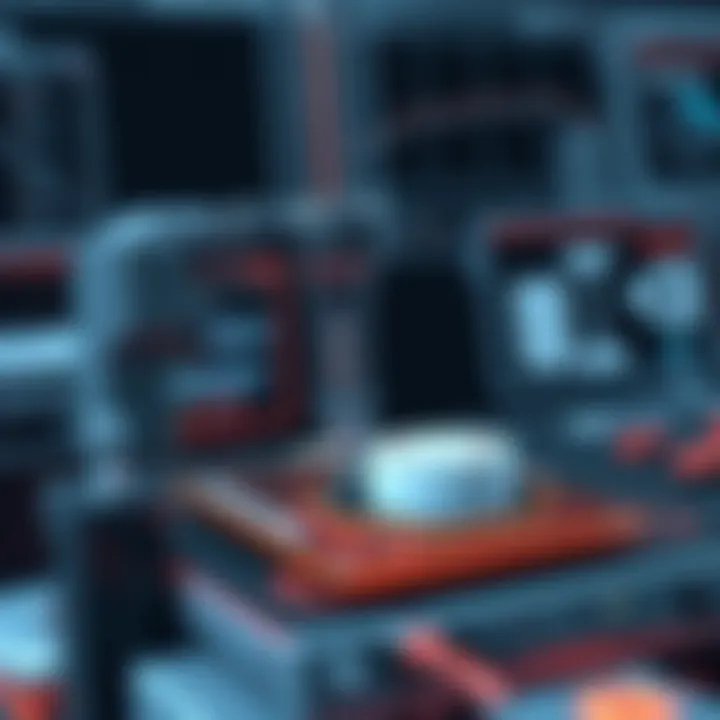Exploring the Impact of Data CAD Software


Intro
Data CAD software has become an essential tool in the design and engineering sectors, streamlining processes that were once labor-intensive. It’s not just about drawing lines or creating shapes anymore; this software plays a pivotal role in managing vast amounts of data associated with design projects. For anyone involved in these fields, grasping the nuances of data CAD is paramount.
This exploration seeks to demystify data CAD software. We will start by examining the key features that distinguish different programs, delve into pricing structures and plans, and reflect on real-world case studies that illustrate successful implementations. As we move through this terrain, we aim to equip professionals, whether they are seasoned engineers or newcomers, with the insights needed to select the right software for their needs and maximize its potential in their work.
Through a combination of clear examples and analytical assessments, we hope to shed light on the transformative impact of data CAD tools. Throughout this article, keywords pertinent to the industry will naturally weave into the discussion, ensuring readers can easily find and digest this information aligned with current market demands.
Thus, let’s embark on this insightful journey into the realm of data CAD software, starting with the critical aspects of its key features.
Prelims to Data CAD Software
In today's fast-paced technological landscape, an understanding of Data CAD (Computer-Aided Design) software is not just beneficial; it is essential. As industries espouse digital transformation, the demand for advanced design solutions magnifies. Data CAD software stands at the crossroads of efficiency, accuracy, and innovation, fundamentally reshaping how designs are conceived and executed across various fields such as architecture, engineering, and manufacturing.
Definition and Scope
Data CAD software refers to a suite of tools that assists in the creation, modification, analysis, or optimization of designs. This software can be integral to a variety of disciplines, including but not limited to architecture, electrical and mechanical engineering, and product design. At its core, CAD enables users to visualize complex projects, simulating real-world implications, and providing clarity that traditional drawing methods simply cannot. The scope of Data CAD extends beyond mere drafting. It encompasses various functionalities like simulation, rendering, and machining, often seamlessly integrated to enhance the design process. Parameters can be adjusted, optimized, and stored, enabling rapid prototyping and iteration, which is crucial in today’s market driven by quick turnarounds.
Importance in Modern Design
In modern design, Data CAD software is akin to having a Swiss army knife. With a vast array of tools at their disposal, designers can tackle tasks that would have once required numerous specialists. This versatility is vital in collaboration, allowing teams to work in tandem—not just geographically, but across disciplines.
“Data CAD empowers professionals to bring their visions to life with precision that was unimaginable a few decades ago.”
The ability to share and modify designs in real-time is a formidable advantage. From generating detailed schematics to executing 3D models that can be animated and manipulated, Data CAD software enhances productivity and brings opportunities for innovation. Enhanced accuracy, reduced human error, and improved client visualization are other critical benefits. Industry leaders increasingly prioritize these software tools, recognizing that they are not just a luxury but a necessity for remaining competitive.
In summary, understanding Data CAD software is imperative for professionals aiming to excel in their respective fields. As its capabilities evolve, staying informed about these tools is essential for anyone involved in design or engineering—and ultimately, those who wish to lead rather than follow in their industries.
Types of Data CAD Software
The realm of CAD software has witnessed substantial evolution over the years, diversifying into various types that cater to specific needs within the design and engineering sectors. Understanding these different categories is crucial for professionals aiming to make informed decisions about the software tools most suited to their workflows. Each type offers unique benefits and considerations that can significantly impact design outcomes, efficiency, and collaboration.
2D CAD Software
2D CAD software has been the cornerstone of technical drawing and documentation for decades. It allows designers to create two-dimensional representations of objects, which serve as blueprints for various applications ranging from machinery parts to architectural plans. Notable examples include AutoCAD and DraftSight.
The significance of 2D CAD lies in its simplicity and precision. Users can meticulously draft layouts with exact dimensions and annotations. The software is typically user-friendly, making it a strong starting point for newcomers in the field. Additionally, 2D designs are often quicker to create, allowing for rapid iteration and client feedback.
However, practitioners should note that while 2D CAD is effective for straightforward projects, it lacks the depth provided by 3D rendering. Thus, designers working on more complex projects might find 2D CAD limiting in terms of visualization and spatial understanding.
3D CAD Software
3D CAD software represents a leap forward in design capabilities, enabling users to create three-dimensional models that not only enhance visualization but also foster better interaction with designs. Noteworthy programs such as SolidWorks and Autodesk Inventor equip designers with tools to manipulate objects within a virtual space, offering the ability to explore different angles and perform simulations.
The advantages of 3D CAD are manifold. First, it provides a more realistic representation of the final product, which can be invaluable during client presentations. Second, it allows for comprehensive testing of design tolerances and integration with other systems. Thus, engineers can identify potential issues early in the design stage, ultimately saving time and resources.
Yet, 3D software tends to come with a steeper learning curve compared to its 2D counterparts. The complexity of features can overwhelm new users. Therefore, companies should weigh the need for advanced visualizations against training time and costs.
Parametric CAD Software
Parametric CAD software introduces a revolutionary concept into the design workflow by allowing users to create models that can automatically update based on specific parameters or constraints. This means that a change made to one part of the design will automatically adjust related components, thus maintaining the overall integrity of the project. This category includes applications like PTC Creo and Siemens NX.
The primary benefit of parametric modeling lies in its efficiency and flexibility. Designers can rapidly iterate designs while ensuring alignment with predefined specifications. It is especially popular in industries like aerospace and automotive, where precision and adaptability are crucial.
On the flip side, new users might struggle with grasping the paradigms of parametric modeling compared to traditional drawing methods. A good understanding of parameters is essential for effective use.
Cloud-Based CAD Solutions
In recent years, cloud-based CAD solutions have surged, marking a significant shift in how design teams collaborate. Programs like Onshape and Fusion 360 allow users to access their designs from anywhere, given they have an internet connection. This flexibility proves invaluable for teams spread across different geographies.
The benefits are clear: it fosters real-time collaboration, reduces the need for extensive hardware investments, and simplifies version control issues, as all changes occur in a centralized location. Furthermore, cloud software often comes with built-in tools for sharing and feedback, streamlining the communication process.
Nevertheless, users must remain vigilant about data security and reliability, as their work is hosted online. Companies should also consider the learning phase needed for their teams to adapt to cloud interfaces.
Understanding these various types of CAD software opens a door to improved design processes, allowing professionals to select tools that best fit their goals. It’s not just about choosing software; it's about embracing a platform that drives efficiency, collaboration, and innovation in their projects.
Key Features of Data CAD Software
Data CAD software serves as the backbone for modern design and engineering, integrating complex calculations and rendering capabilities into manageable workflows. To leverage the full potential of these tools, understanding their key features is essential. Each feature not only contributes to the software's core functionality but also provides growing businesses and seasoned professionals with vital advantages, enhancing productivity and creativity. In this section, we explore some of the fundamental characteristics that define high-quality Data CAD software, emphasizing their importance in decision-making for tech-savvy users.
User Interface and Usability
When first engaging with any software, the user interface (UI) stands out as the initial point of interaction. A sleek, intuitive UI can significantly reduce the learning curve for new users. Many advanced Data CAD options offer a customizable workspace, allowing users to arrange tools and menus according to their working style. This flexibility is particularly beneficial in collaborative environments, where team members may have diverse preferences.
- Visual Hierarchy. A well-organized interface allows for easy navigation. Functions are grouped logically, ensuring users can find tools without second-guessing.
- Keyboard Shortcuts. Many professionals swear by keyboard shortcuts, which can steeply cut down the time spent on repetitive tasks. This feature allows for greater efficiency.
Having a user-friendly interface can not only boost productivity but also empower users to tap into features they might neglect due to complexity.
File Compatibility and Integration
In today's fast-paced design world, file compatibility is non-negotiable. Data CAD software must seamlessly integrate with various file types and other software applications, enabling designers to import, export, and collaborate with ease.
- Industry Standards. Compatibility with popular file formats like DWG, DXF, STL, and others is essential. Many design professionals work with legacy files or share information with various stakeholders, so recognizing different formats is vital.
- APIs and Plugins. Quality CAD software often supports third-party integrations that expand functionality. Through APIs (Application Programming Interfaces) and plugins, users can enhance or tailor software features, making the integration smooth and efficient.


Ensuring that your chosen Data CAD solution is compatible with the tools frequently utilized in your industry can save time, prevent costly errors, and facilitate collaboration.
Collaboration Tools
Effective collaboration can mean the difference between a successful project and a missed deadline. As teams often work together from different locations nowadays, having robust collaboration tools inside Data CAD software becomes a must.
- Real-time Updates. Features allowing multiple users to work on the same project simultaneously are crucial. Changes are visible in real-time, making it easier to respond and adapt.
- Commenting and Feedback. Integration of commenting tools directly within the CAD environment helps teams clarify design concepts and provide immediate feedback, maintaining a continuous flow of communication.
Fostering team collaboration through built-in tools directly impacts project success, helping stakeholders stay aligned throughout the development process.
Customization Capabilities
Every design project is unique, and so are the needs of the professionals handling the job. Customization features allow users to modify the tools and environment to meet those specific needs.
- Personalized Toolbars. Many CAD programs let users select which tools appear in their interface, increasing accessibility for commonly used functions.
- Scripts and Macros. Users proficient in programming may benefit from developing scripts or macros to automate repetitive tasks, freeing them for more creative problem-solving.
Customization not only enhances user experience but also makes the software as functional as possible for each unique project undertaken.
"The right tools, tailored to your needs, can make the impossible achievable."
In summary, the key features of Data CAD software are fundamental in maximizing efficiency and creativity in the design process. By focusing on user interface, compatibility, collaboration tools, and customization, businesses can make informed decisions when selecting the right tool for their team. Understanding these elements ensures individuals can navigate the complexities of modern design with confidence, driving project success through tailored and efficient workflows.
Transformative Impact on Design Workflows
The integration of Data CAD software has reshaped the landscape of design and engineering workflows. Its transformative impact goes beyond mere enhancement of traditional processes; it fundamentally changes how projects are conceived, executed, and managed. Being able to effectively utilize these tools signifies a competitive edge in today’s fast-paced environment, where the margin for error is slim, and the demand for precision is ever-increasing.
Improved Efficiency
When it comes to improving efficiency, Data CAD software isn't just the cherry on top; it’s the whole sundae. Automating repetitive tasks is where it truly shines. Take drafting, for instance. Traditional methods often involve painstakingly creating each line and curve by hand. With CAD software, designers can harness tools like templates and design libraries which allow for rapid prototyping and immediate adjustments. This slashes the time it takes to transition from concept to creation.
Moreover, tasks that once took days or even weeks can now be completed in hours— sometimes even minutes—thanks to features like batch processing and instant rendering capabilities. When teams are no longer bogged down in low-level tasks, they can focus on the creative side of design, leading to more innovative solutions. In a world where every second counts, embracing this software can mean the difference between winning or losing a contract.
Enhanced Accuracy
Accuracy is paramount in design work; a single miscalculation can cascade into costly errors. With Data CAD software, precision is built in. Through parametric modelling, every component can be linked to one another, meaning that any change made to a single element reflects across all related parts. This interconnectedness minimizes the risk of conflicting dimensions or specifications.
Furthermore, advanced simulation features allow for testing designs in a virtual environment before they ever see the light of day. Modeling stresses, thermal impacts, and fluid dynamics can be performed swiftly, offering insights that would once have taken countless manual hours to gather. Users can fine-tune, iterate, and perfect their designs without the anxiety of real-world trial and error.
"In the age of precision, one small oversight can lead to colossal ramifications. Accuracy isn't just a perk; it's a necessity."
Streamlined Communication
Communication in the design process can often feel like a game of broken telephone, where ideas can get misinterpreted or lost in transit. However, Data CAD software provides a centralized platform for collaboration. Features such as cloud-sharing capabilities allow team members to access, comment, and modify designs in real-time, fostering a more inclusive environment. Whether you’re in the same office or halfway across the globe, the technology bridges those gaps effortlessly.
Additionally, integration with project management tools enhances task assignment and milestone tracking. This way, everyone stays on the same page. By utilizing common formats for documentation and sharing, misunderstandings are minimized, and small issues can be addressed before they escalate.
Choosing the Right Data CAD Software
Choosing the right Data CAD software is more than just a check on a wish list; it’s an integral step that lays the foundation for successful design and engineering projects. With a myriad of options available, pinpointing the perfect fit necessitates a thorough understanding of both the business needs and the available tools in the marketplace. This decision not only affects individual workflows but also impacts collaboration, resource allocation, and ultimately, project outcomes.
With rapidly advancing technologies and evolving industry standards, the stakes are higher than ever. Professionals need to be meticulous in their selection process to ensure that the software they choose aligns well with their team’s goals and enhances productivity. Here are the crucial considerations in making an informed choice.
Assessing Business Needs
Before diving headfirst into software options, it is vital to assess the unique needs of the business. Each organization has its specific challenges and goals, which software must address. Here’s how to navigate this process:
- Identify Key Functionalities: List out what functionalities are essential to your projects. Is it more important to have advanced 3D modeling or robust simulation capabilities?
- Involve Stakeholders: Engage with team members across different levels. Their insights can highlight aspects that could easily be overlooked.
- Evaluate Existing Systems: Are you integrating a new tool into an existing ecosystem, or starting fresh? Understanding current systems helps in determining compatibility and potential challenges.
By taking the time to thoroughly assess these factors, firms can avoid the pitfall of selecting software that looks appealing but fails to deliver on practical use.
Evaluating Software Options
With available options in seemingly endless supply, evaluating software requires a strategic approach. Here are some practical steps to follow:
- Research and Review: Leverage resources like reviews on Capterra or user feedback on Reddit to gauge real-world performance and reliability of different CAD software.
- Trial Periods: Make use of free trial offers. Hands-on experience can often reveal much about usability and compatibility than any brochure or site can convey.
- Demonstrations: Request demonstrations from vendors. This often provides a clearer picture of navigation and special features.
- Scalability: Consider whether the software can grow with the business. As projects and teams expand, the CAD tool should be able to keep pace.
Evaluating software in a structured way allows organizations to make decisions based on evidence and known performance, rather than just sales pitches.
Cost Considerations
Lastly, costs can be a significant factor when selecting CAD software. Balancing quality with affordability is an ongoing challenge. Here are some considerations:
- Upfront vs. Long-term Costs: Often, the lowest purchase price doesn’t reflect total cost over time. Consider licensing fees, support costs, and any potential training needs.
- Return on Investment (ROI): Assess how the software’s features might translate into productivity increases or cost reductions in projects.
- Budget Flexibility: Factor in potential costs for add-ons and upgrades. Flexibility in budgeting can help in accommodating unforeseen needs in the future.
Choosing the right Data CAD software is essential in today’s fast-paced environment. Being thorough in evaluating business needs, researching software options, and carefully calculating costs can lead to strategically beneficial decisions that enhance not only project outcomes but overall organizational efficiency.
A well-chosen CAD tool streamlines workflows, improves communication, and ultimately leads to successful project completion.
For further details on CAD software features and industry trends, consider visiting Wikipedia on CAD Software or checking resources like the Engineering Toolbox and Autodesk’s Blog for up-to-date insights.
Market Trends and Innovations
In a world that thrives on technology, market trends and innovations in data CAD software play a pivotal role in shaping the future of design and engineering. As industries continuously evolve, staying abreast of these trends isn’t just an advantage; it's a necessity for survival. The integration of advanced technologies not only improves efficiency but also aligns with growing demands for sustainability and collaboration. The following discussions delve into two significant elements currently at the forefront: AI advancements and sustainable design practices.
Rise of AI in CAD Software


Artificial Intelligence has made inroads into nearly every sector, and CAD software is no exception. The rise of AI is noteworthy because it brings both capabilities and challenges. AI-enhanced CAD systems, like Autodesk's Fusion 360, leverage machine learning algorithms to analyze design patterns. This means these systems can offer suggestions that optimize designs based on historical data and user preferences.
One significant benefit of this integration is the automation of repetitive tasks. Designers can automate the creation of complex geometries, freeing them to focus on creativity rather than mundane operations. This is not just time-saving—it can also lead to greater innovation, as the artificial intelligence can sift through vast datasets to provide insights that a human might overlook.
Moreover, predictive analytics plays a crucial role here. AI can forecast design outcomes based on initial conditions, thus reducing the need for costly physical prototypes. It enables creators to visualize potential issues before they arise. However, the adoption of AI-driven tools does come with its own hurdles, especially regarding the learning curve and the initial setup costs. For businesses, understanding these complexities becomes vital to make informed decisions.
Sustainability in Design Practices
The concept of sustainability is becoming increasingly important in every business arena, and design practices are no different. Data CAD software is evolving in ways that optimize for sustainability. Using tools like SolidWorks Sustainability, designers can assess materials and energy consumption right from the design phase. Such capabilities allow for more environmentally friendly designs by providing insights into the lifecycle impact of various choices.
The shift towards sustainable practices isn’t merely a trend; it’s a necessary response to global challenges. CAD software now incorporates databases that help designers select eco-friendly materials, providing alternatives that minimize carbon footprints. Committing to sustainability not only addresses regulatory requirements but can also enhance brand reputation and customer loyalty.
"Innovative design practices that consider sustainability are no longer optional; they are vital for competitive advantage in a marketplace increasingly focused on environmental responsibility."
However, implementing such practices requires a cultural shift within organizations. It involves training personnel to think differently about the materials they choose and the methods they utilize. Businesses need to foster an environment where sustainable innovations are encouraged, ensuring that every team member understands their role in this shift.
For further reading on the importance of AI in modern design tools, check out resources from Wikipedia or Britannica. For insights into sustainable practices, visit the U.S. Environmental Protection Agency website.
Case Studies of Successful Implementations
Examining real-world applications of data CAD software provides vital insights into how these tools perform under the demands of various industries. Case studies showcase the practical advantages and challenges firms face when integrating CAD systems into their workflows. They highlight specific elements like technology adaptation, collaboration, and efficiency gains. Benefits such as reduced production time, enhanced accuracy, and better communication across teams are vital considerations in these analyses. They provide a window into how cutting-edge software solutions can reshape processes, and they offer lessons for businesses seeking to harness these tools effectively.
Manufacturing Sector
In manufacturing, data CAD software has become a game-changer. A notable case is Boeing, which has utilized advanced CAD tools to optimize its aircraft design process. Through rigorous modeling and simulation, the firm realized substantial declines in design time—by up to 50% in some instances.
The integration of CAD software allowed Boeing to visualize parts in 3D, reducing the chances of errors that could emerge during the production phase. In turn, this has led to significant savings in materials and labor costs. Additionally, the increase in collaboration between engineering teams facilitated better feedback loops, leading to quicker iterations of design.
Key Takeaways:
- Enhanced design accuracy.
- Significant cost reductions.
- Improved inter-departmental collaboration.
Overall, the manufacturing sector showcases how robust software solutions can help streamline processes, reduce waste, and lead to more innovative outcomes.
Architecture and Construction
When it comes to architecture and construction, data CAD software plays a crucial role in creating effective designs. A prime example can be found in the New York Times Building project. The architects employed Autodesk Revit to design intricate details while managing complex structural equations. This method allowed the design team to meet tight deadlines without sacrificing quality.
The software's ability to facilitate real-time changes meant that stakeholders, including clients and contractors, could see alterations instantaneously. Moreover, construction teams were able to detect potential clashes early through the Building Information Modeling (BIM) capabilities integrated within the software.
Advantages Observed:
- Faster turnaround times on revisions.
- Real-time collaboration between stakeholders.
- Early detection of design flaws.
This case in architecture highlights the significant innovations that CAD technology can bring to even the most complex projects.
Automotive Industry
The automotive industry has also reaped considerable benefits from data CAD software. A leading instance is Ford Motor Company, where data-driven design processes have streamlined vehicle development. Using SolidWorks, their engineers were able to create detailed 3D models that provide insights into every aspect of vehicle performance, from aerodynamics to structural integrity.
The time-to-market for new vehicle models was notably shortened, thanks to the simulation capabilities of the CAD software. Additionally, the software enables Ford to conduct continuous testing throughout the design phase, which helps catch defects before physical prototypes are built.
Critical Outcomes:
- Decreased time-to-market for new models.
- Enhanced product quality through simulations.
- Cost savings due to fewer physical prototypes required.
Ford's experience within the automotive sector demonstrates the essential role that data CAD software plays in driving innovation and efficiency.
"Successful implementation of data CAD software in these industries exemplifies how technology can fundamentally alter operational paradigms, leading to greater competitiveness and design excellence."
Through these case studies, it’s clear that successful implementation of data CAD software opens the door to innovation, efficiency, and collaborative success across diverse industries.
Best Practices for Integration
Integrating data CAD software into an organization’s operations can be a significant undertaking. It’s not just about installing a program; it’s about weaving it into the fabric of how the team works. Best practices in this arena ensure that the software becomes a valuable tool rather than a source of frustration. Here, we break down the critical elements surrounding successful integration, touching on training, data management, and continual feedback mechanisms.
Training and Support
First and foremost, training is not merely supplementary; it is foundational for effective use of data CAD software. Without a solid understanding of the software, teams may find themselves lost in an ocean of features, only using a fraction of the program's capabilities. Moreover, software vendors often provide training resources, but their effectiveness can vary widely.
A well-structured training program should encompass several key areas:
- Comprehensive Onboarding: This should occur at the moment of software implementation, ensuring users can hit the ground running.
- Role-Specific Training: Different roles may require different skills; hence, tailoring sessions can enhance efficiency.
- Ongoing Support Mechanisms: Regular refreshers and updates on new features are crucial.
By establishing a robust support system, organizations can widely improve user proficiency while minimizing the risk of errors that come from misunderstanding the software's functionality.
Data Management Strategies
In the realm of CAD, data doesn't sit still; it's constantly changing. Therefore, having effective data management strategies is not just smart—it's essential. Implementing a well thought out strategy ensures that the data flowing in and out is accurate, up-to-date, and secure. This is particularly important for organizations that handle sensitive projects.
Consider the following approaches for robust data management:
- Centralization: Keeping all data within a centralized repository eliminates confusion and reduces the risk of errors caused by data silos.
- Regular Audits: Conducting periodic reviews of data integrity can catch mistakes before they snowball into larger issues.
- Version Control: Implementing version control mechanisms ensures teams always work from the latest files, preventing headaches from outdated documents.
With these measures in place, organizations can foster an environment where data is leveraged effectively, enhancing overall productivity.


Feedback Mechanisms
Lastly, establishing feedback mechanisms is paramount for continuous improvement. Integration shouldn’t be seen as a one-and-done affair; rather, it needs to evolve with the users’ needs and advancements in technology. Feedback loops can take many forms, and getting this right is essential.
Here are some effective strategies for implementing feedback:**
- Regular Check-Ins: Scheduling periodic meetings allows team members to voice concerns and suggestions openly.
- Surveys and Polls: Anonymous surveys can capture honest opinions, making it easier for employees to share their thoughts.
- Suggestion Boxes: Both digital and physical boxes can encourage contributions from those who may be hesitant to speak up in meetings.
By actively seeking and incorporating feedback, organizations can create a dynamic that encourages innovation and adaptability, significantly enhancing how data CAD software is utilized.
"In the world of design and engineering, not adapting to new tools is akin to trying to land a plane without a runway."
In summary, best practices for integration of data CAD software are not just a checkbox to tick but essential steps that can spell the difference between success and disarray. Prioritizing comprehensive training, robust data management, and proactive feedback mechanisms helps cultivate a thriving environment where organizations can fully harness the potential of their CAD tools. This not only makes the software work harder for you but also helps cement a culture of ongoing growth and efficiency.
Challenges in Data CAD Implementation
Implementing Data CAD software comes with its fair share of challenges that can test even the most seasoned professionals. Understanding these obstacles is paramount in navigating the complex landscape of design and engineering. Addressing these challenges effectively can lead to streamlined operations, enhanced productivity, and ultimately, greater success for businesses. The section below breaks down the primary difficulties faced during implementation, specifically focusing on technical limitations and resistance to change.
Technical Limitations
When it comes to Data CAD software, technical limitations often top the list of hurdles. These may include software compatibility issues, hardware requirements, and system integration challenges. For instance, many organizations find themselves grappling with older systems that simply cannot support the latest software updates. This results in stalled projects, as teams are forced to either invest in costly upgrades or remain stuck with outdated tools.
Think about an engineering firm that relies on legacy systems to run critical operations. A switch to an advanced Data CAD software might promise improved functionalities, but if the existing hardware can't handle the new load, productivity can take a nosedive. Moreover, compatibility issues can arise when trying to share files across different platforms; what good is a cutting-edge tool if it can't communicate with the software your partners use?
Integrating CAD software into existing workflows isn't just about installing a new program; it often requires a comprehensive reassessment of current technological infrastructures.
"In an industry that runs on precision and collaboration, a lapse in technical compatibility can cost time and money, underscoring the need for thoughtful planning and execution during CAD adoption."
A few key limitations may involve:
- Insufficient Hardware: Older machines can't process complex designs efficiently.
- Software Compatibility: Issues arise when different departments use conflicting software versions.
- Integration Challenges: Merging new tools with legacy systems may lead to significant disruptions.
Undoubtedly, tackling these technical limitations is crucial in ensuring successful Data CAD implementation.
Resistance to Change
Change, as they say, is the only constant in life, but it sure doesn’t feel that way for many teams when it comes to adopting new Data CAD software. Resistance to change can stem from multiple sources within an organization. Employees accustomed to existing processes and tools might feel overwhelmed or anxious about mastering new systems. This reluctance can lead to a pervasive culture of complacency where innovation gets kicked to the curb.
In practical terms, when staff are hesitant to adapt, it can result in a lack of engagement with the new software, or worse, a few individuals might actively avoid utilizing its full capabilities. This isn’t just a problem of missed opportunities; it can also create significant barriers to collaboration. Everyone needs to be on the same page for a team to effectively work on projects. When some continue using old methods while others acclimate to the new software, confusion reigns.
To address this challenge, organizations must prioritize change management alongside technical deployment. Training sessions and ongoing support can facilitate smoother transitions. Enabling a supportive environment can encourage employees to voice concerns and share feedback. The goal here is to foster a culture where technological evolution is not just accepted but embraced.
Some strategies to combat resistance may include:
- Comprehensive Training Programs: Equip staff with the knowledge they need to feel confident using new tools.
- Open Communication Channels: Foster an environment where team members can discuss their concerns and suggestions.
- Recognition of Adoption Efforts: Celebrate milestones achieved during the transition to encourage further engagement.
Overall, recognizing and addressing resistance to change will play a significant role in the successful integration of Data CAD into workflows.
Navigating these challenges requires not only technical foresight but also a human touch that recognizes the myriad of factors influencing software adoption.
Future Outlook for Data CAD Software
In an era characterized by rapid technological evolution, the future of Data CAD software seems to be teetering on the brink of remarkable advancements. Like a compass guiding architects and engineers through uncharted waters, the proper understanding of these future developments holds significant implications for both individual projects and the broader industry. This section aims to offer a comprehensive perspective on emerging technologies that are shaping Data CAD software and anticipated market shifts that companies should be prepared for as they navigate this digitally driven landscape.
Emerging Technologies
Technological innovation within Data CAD software isn't just a flash in the pan; it's a swelling tide. From machine learning algorithms that can predict design failures to augmented reality interfaces that allow designers to visualize concepts in real-time, the breadth of emerging technologies is impressive. Here are some noteworthy advancements:
- Artificial Intelligence: Machine learning models can evaluate numerous design iterations in record time, making suggestions that human designers could take hours to recognize, effectively speeding up the creative process.
- Virtual Reality and Augmented Reality: These technologies allow for immersive experiences where users can manipulate designs in a three-dimensional space, which can be incredibly helpful during client presentations. It's like holding the blueprints of your dreams in your very hands.
- Generative Design: This innovative approach uses algorithms to create numerous design alternatives based on specific parameters. It can serve as a springboard for creativity, enabling architects to explore forms and functions that might not have been initially considered.
With these technologies coming into play, understanding how to leverage them becomes critical. To remain competitive, firms must embrace these advancements, ensuring their teams are trained and equipped to utilize these tools effectively.
Anticipated Market Shifts
As the Data CAD software landscape evolves, market dynamics are likely to shift in tandem with these emerging technologies. Here are a few trends to watch:
- Increased Demand for Cloud-Based Solutions: The drive toward remote work has intensified the need for collaborative, cloud-based CAD solutions which enable teams to work seamlessly, regardless of their physical locations. This includes not just file sharing, but also real-time collaborative design capabilities.
- Focus on Sustainability: As environmental concerns increasingly take center stage, CAD software is likely to evolve to prioritize sustainable design practices. Features that analyze material efficiency or energy consumption may become standard, helping designers create greener buildings without sacrificing aesthetic qualities.
- Integration of IoT and Smart Technologies: The Internet of Things is shaping how designs are conceived. Imagine CAD tools that can pull live data from operational sensors in existing buildings, allowing designers to adapt spaces based on gravitational shifts or structural health over time.
"By anticipating these changes, companies can safeguard their future and harness new opportunities created by technological advancements."
For further insights on the evolving landscape of Data CAD software, consider exploring the following resources:
As Data CAD software continues to evolve, it offers a promising horizon for innovation, efficiency, and collaboration.
Epilogue
In this digital age, recognizing the importance of data CAD software is vital for anyone involved in the design and engineering sectors. The culmination of this exploration delves into how CAD software empowers professionals and organizations to create more efficiently, communicate seamlessly, and innovate continuously.
Recap of Key Insights
Throughout our discussion, we have traversed various dimensions of data CAD software:
- Variety of Software: We highlighted different types of CAD software such as 2D, 3D, and parametric applications, each serving unique design needs.
- Features That Matter: The focus on user interface, file compatibility, and collaboration tools shows that modern software needs to be more than just functional; it must also cater to user experience.
- Transformative Benefits: Improved efficiency, accuracy, and communication capabilities illustrate the profound impact on workflows, enabling teams to deliver projects more effectively.
- Future Trends: As we peered into the horizon, emerging technologies and AI's incorporation signal a transformative future that can reshape traditional practices.
This recap serves to underscore the deep interconnection between CAD software and modern design, emphasizing that choosing the right tools can lead to significant competitive advantages, especially in industries where precision and speed are paramount.
Final Thoughts
In closing, the world of data CAD software is intricate yet essential, offering a breadth of functionalities that enable professionals to push the boundaries of design. For IT experts, business decision-makers, and engineers alike, understanding the nuances of this software can lead to more informed decisions that foster innovation and operational excellence.
Consider your unique needs, explore the options available, and bear in mind the upcoming trends shaping this landscape. The goal here isn’t just to keep pace; it’s to be at the forefront—designing the future with efficiency, creativity, and precision.







